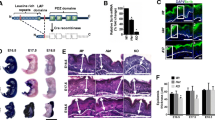Abstract
Stratifin (Sfn, also called 14-3-3σ) is highly expressed in differentiating epidermis and mediates cell cycle arrest. Sfn is repressed in cancer, but its function during development is uncharacterized. We identified an insertion mutation in the gene Sfn in repeated epilation (Er) mutant mice by positional cloning. Er/+ mice expressed a truncated Sfn protein, which probably contributes to the defects in Er/Er and Er/+ epidermis and to cancer development in Er/+ mice.


Similar content being viewed by others
Accession codes
References
O'Shaughnessy, R.F. & Christiano, A.M. Int. J. Dev. Biol. 48, 171–179 (2004).
Hunsicker, P. Mouse News Letter 23, 58 (1960).
Lutzner, M.A., Guenet, J.L. & Breitburd, F. J. Natl. Cancer Inst. 75, 161–166 (1985).
Guenet, J.L., Salaun, J. & Salzgeber, B. in Handbook of Mouse Mutation with Skin and Hair Abnormalities (ed. Sundberg, J.P.) 399–405 (CRC, Boca Raton, 1994).
Fisher, C., Jones, A. & Roop, D.R. J. Cell Biol. 105, 1807–1819 (1987).
Dellambra, E. et al. J. Cell Biol. 149, 1117–1130 (2000).
Hermeking, H. Nat. Rev. Cancer 3, 931–943 (2003).
Lopez-Girona, A., Furnari, B., Mondesert, O. & Russell, P. Nature 397, 172–175 (1999).
Rittinger, K. et al. Mol. Cell 4, 153–166 (1999).
Wilker, E.W., Grant, R.A., Artim, S.C. & Yaffe, M.B. J. Biol. Chem. 280, 18891–18898 (2005).
Xing, H., Zhang, S., Weinheimer, C., Kovacs, A. & Muslin, A.J. EMBO J. 19, 349–358 (2000).
Benzinger, A., Muster, N., Koch, H.B., Yates, J.R. III & Hermeking, H. Mol. Cell. Proteomics 4, 785–795 (2005).
Acknowledgements
We thank D. Green, S. Vitelli, M. Wingrave and the Wadsworth Center Molecular genetics core and Transgenic mouse cores for technical assistance; E. Pequignot and G. Kusek for statistical analyses; L. Flaherty, D. Symula, T Gray, M. Ryan and R. Peitropalo for critical review of this manuscript; and all investigators who provided probes for mapping studies. This research was supported in part by grants from the US National Cancer Institute and from the New York State Office of Science, Technology and Academic Research.
Author information
Authors and Affiliations
Corresponding author
Ethics declarations
Competing interests
The authors declare no competing financial interests.
Supplementary information
Supplementary Fig. 1
Keratinocyte proliferation data. (PDF 34 kb)
Supplementary Fig. 2
Genetic mapping data. (PDF 145 kb)
Supplementary Fig. 3
Inbred strain haplotype analysis. (PDF 97 kb)
Supplementary Table 1
Informative loci surrounding Sfn. (PDF 14 kb)
Rights and permissions
About this article
Cite this article
Herron, B., Liddell, R., Parker, A. et al. A mutation in stratifin is responsible for the repeated epilation (Er) phenotype in mice. Nat Genet 37, 1210–1212 (2005). https://doi.org/10.1038/ng1652
Received:
Accepted:
Published:
Issue Date:
DOI: https://doi.org/10.1038/ng1652
- Springer Nature America, Inc.
This article is cited by
-
Evaluation of 14-3-3 sigma as a potential partner of p16 in quiescence and differentiation
In Vitro Cellular & Developmental Biology - Animal (2018)
-
KDF1, encoding keratinocyte differentiation factor 1, is mutated in a multigenerational family with ectodermal dysplasia
Human Genetics (2017)
-
The role of barrier genes in epidermal malignancy
Oncogene (2016)
-
14-3-3σ Regulates Keratinocyte Proliferation and Differentiation by Modulating Yap1 Cellular Localization
Journal of Investigative Dermatology (2015)
-
Cetaceans evolution: insights from the genome sequences of common minke whales
BMC Genomics (2015)





